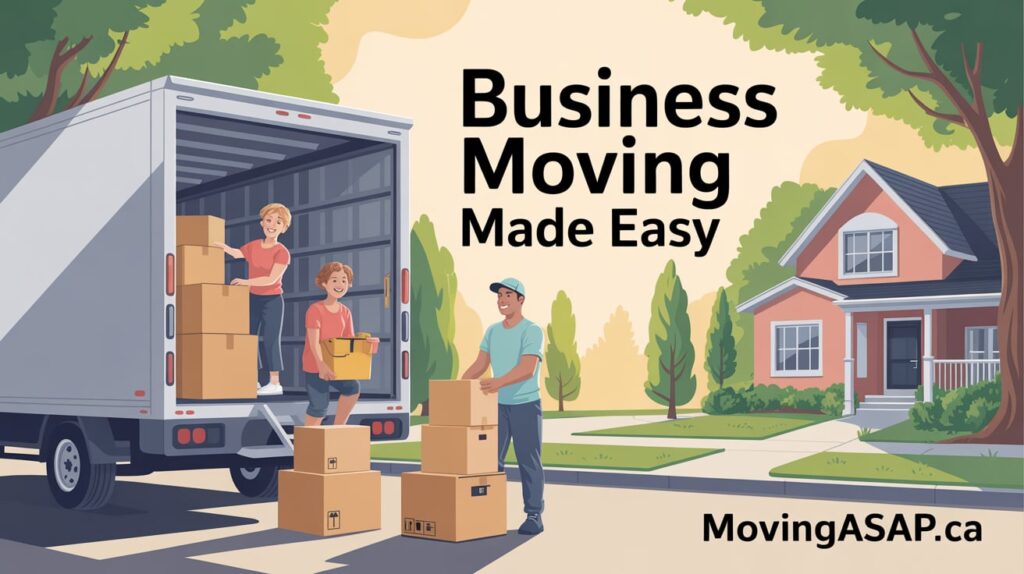Moving a business is no small task. Unlike residential moves, office and commercial relocations involve more planning, coordination, and responsibility. From shifting workstations and IT setups to moving essential documents and equipment, every detail matters. If you’re preparing for a move in Canada, Business Moving Made Easy is more than just a phrase—it’s a step-by-step approach that ensures your company continues running smoothly before, during, and after the transition.
At MovingASAP, we understand the challenges businesses face when relocating. This guide will walk you through every stage of the process, including planning, packing, transportation, and post-move setup. You’ll also see why working with professional commercial movers is the most reliable way to protect your assets and save time.
Why Business Relocation Requires Special Planning
Business moves are different from household relocations. While moving a home may affect only a few people, moving an office impacts employees, clients, and the company’s workflow.
Some key challenges businesses face include:
- Minimizing downtime so operations continue with little disruption.
- Protecting valuable assets such as computers, printers, and office furniture.
- Coordinating schedules across departments to keep the team aligned.
- Handling sensitive documents securely during the move.
When done without planning, a move can cause missed deadlines, lost files, or employee stress. That’s why a structured approach is essential.

Step 1: Start With a Moving Plan
A business move starts long before the moving truck arrives. A clear plan will help you stay organized.
Key elements of a moving plan include:
- Timeline – Decide on a moving date well in advance and set milestones.
- Budget – Estimate the cost of movers, packing materials, new furniture, and IT setup.
- Inventory – List all equipment, furniture, and documents that need to be moved.
- Responsibilities – Assign team members to handle communication, packing, and coordination.
Example: If your Toronto office is moving to Ottawa, a timeline could start six months ahead, with tasks like notifying employees, scheduling IT support, and booking movers.
Step 2: Choose the Right Moving Partner
The company you choose will directly affect the success of your move. A professional mover with experience in office relocation ensures everything is packed, loaded, and delivered on time.
When choosing a moving partner in Canada, consider:
- Experience with commercial moves
- Licensing and insurance coverage
- Customer reviews and reputation
- Ability to handle long-distance moves
- Services offered (packing, unpacking, storage, IT relocation)
MovingASAP specializes in business moves across Canada, offering trusted support for both local and long-distance relocations.
Step 3: Prepare Your Office for the Move
Before moving day, prepare your current office space.
- Declutter: Dispose of old files, broken chairs, or unused electronics.
- Label everything: Mark boxes with their department and content for easier unpacking.
- Back up digital data: Ensure all files are saved before IT systems are disconnected.
- Inform stakeholders: Notify clients, suppliers, and partners about your new address.
Example: A law firm moving within Toronto could label files by case number to avoid confusion when setting up the new office.
Step 4: Packing and Transportation
Professional packing ensures that sensitive equipment and documents arrive safely. At MovingASAP, we use durable packing supplies and techniques designed for office items.
- Computers and electronics are packed with anti-static wraps.
- Office furniture is disassembled, protected, and reassembled after arrival.
- Important files are packed securely to maintain confidentiality.
- Specialized equipment is handled with care and precision.
For transportation, commercial moving trucks with lift gates and climate protection help reduce risks.
Step 5: Setting Up the New Office
Once you arrive at the new location, the goal is to return to normal operations quickly.
Tasks after arrival include:
- Setting up IT systems and testing internet connections.
- Reassembling furniture and arranging workstations.
- Unpacking files and restoring access to key documents.
- Confirming that security systems and entry passes are working.
With professional movers, this process becomes faster and less stressful.
The Benefits of Hiring Professional Business Movers
Working with a trusted moving company like MovingASAP provides several advantages:
- Time savings: Employees can focus on their work instead of packing.
- Safety: Heavy furniture and electronics are moved with proper equipment.
- Reduced downtime: Movers work efficiently to limit interruptions.
- Insurance protection: Your assets are covered during the move.
- Expertise: Commercial movers know how to handle IT equipment and sensitive files.
Local and Long-Distance Business Moves in Canada
Whether your company is relocating across the street or to another province, the process requires careful management.
- Local Business Moves: Ideal for small offices shifting within the same city, like Toronto to Mississauga.
- Long-Distance Business Moves: Essential for companies expanding from Ottawa to Vancouver or Calgary.
MovingASAP handles both, ensuring consistent quality no matter the distance.

Common Mistakes to Avoid in Business Moves
- Waiting too long to plan.
- Underestimating the moving budget.
- Forgetting to notify clients and suppliers.
- Relying on employees to handle the entire move.
- Not backing up digital data.
Avoiding these mistakes will make your move smoother and stress-free.
Example Case Study: Toronto IT Company Relocation
A mid-sized IT company in Toronto needed to move to a larger office in Ottawa. They faced challenges with expensive servers, employee workstations, and strict deadlines.
By hiring MovingASAP, they created a detailed plan, packed sensitive IT equipment with professional-grade materials, and completed the move over a weekend. On Monday, employees resumed work without disruption.
This real-world example shows how professional movers make business relocation easier and safer.
FAQs: Business Moving Made Easy in Canada
Q1: How far in advance should I plan a business move?
Start planning at least 3–6 months ahead to cover all logistics and coordination.
Q2: How can I reduce downtime during a move?
Schedule the move on weekends or holidays, and work with movers who can handle IT setups quickly.
Q3: Do professional movers handle confidential documents?
Yes, trusted movers like MovingASAP use secure packing methods for sensitive files.
Q4: What’s the difference between commercial and residential moving?
Commercial moves focus on office furniture, IT equipment, and documents, while residential moves focus on personal belongings.
Q5: Can MovingASAP handle long-distance corporate relocations?
Yes, we provide both local and long-distance business moving services across Canada.
Final Thoughts
Relocating a business can be complex, but with the right approach, it becomes manageable. By planning ahead, choosing a trusted partner, and focusing on smooth execution, Business Moving Made Easy isn’t just a slogan—it’s a reality.
At MovingASAP, we’ve helped companies across Canada relocate offices, warehouses, and commercial spaces without losing valuable time or assets. Whether you’re planning a local move in Toronto or a long-distance relocation across provinces, our team is here to support you every step of the way.

